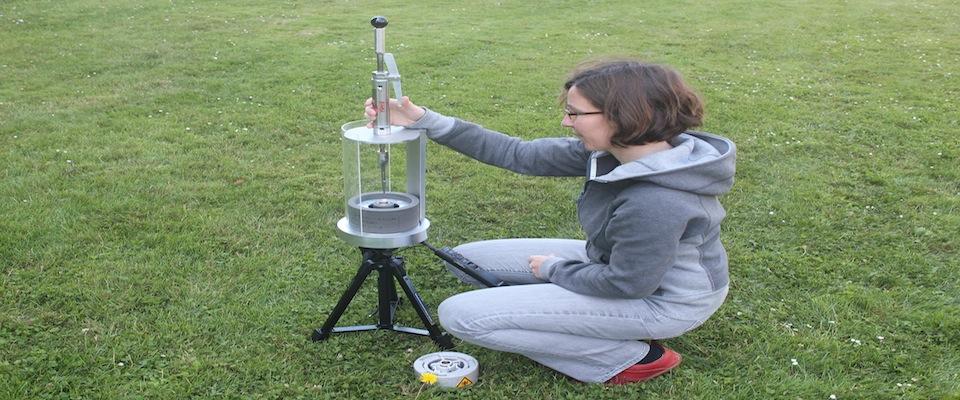Marcus Lehmann is at work alongside a 50-meter-long water tank in a high-ceilinged engineering lab at UC Berkeley’s O’Brien Hall, surrounded by wrenches, tape, wires, electronics, pipes, lab notebooks and other flotsam and jetsam. Within the tank, he generates ocean-like waves to test a promising invention: a carpet-like device that captures wave energy. It holds the promise of someday being able to harness the power of the ocean, a potential huge source of renewable energy.
But to continue his work, Lehmann needed money—and because fast funding for basic science research is hard to come by, he opted to appeal to the masses via the online site Experiment.com. His online solicitation page included an overview, budget, graphs, video, and a group photo of the researchers. The page’s title: “Can we solve future energy and freshwater crises with the power of ocean waves?”
Up the Pacific Coast in the Washington town of Sequim, 48-year-old graphic designer Elizabeth Whitmore learned about Lehmann’s project via a crowdfunding podcast, and became a supporter. “It’s awesome to give money to science,” she says. “Is it going to change the world, or solve global warming, or stop cancer? It gives me a good feeling to know that I’m contributing to something worthwhile.” In New York City, V. Faye McNeill, an associate professor of chemical engineering at Columbia University, read about the project and kicked in as well. “During my own crowdfunding campaign back in March, I made donation pledges to several projects which I thought were interesting and worthy,” she explains, “and Marcus’s was one of them.” In Alabama, an 80-year-old retired teacher was also intrigued by Lehmann’s wave energy research, and pledged a dollar.
So Lehmann’s big news today is not an engineering breakthrough; it’s the successful completion of his crowdfunding campaign. He has raised $9,622 from 77 backers in 60 days—money to pay for needed hydraulic pumps, gauges, and magnetic flow meters.
“At the moment, our project is not well-funded, and the entire grant process has a very long review cycle,” he says. “We recently applied for a (federal Department of Energy) grant, but they are only funding more mature technologies. I kind of had to self-finance, so I was looking for scholarships, research scholarships, and I randomly stumbled upon this campaign page Experiment.com.”

News flash for those who think basic research funding exists only in the realm of government and industry: In the last five years ‘big science’ has become more associated with ‘big budget cuts’.
At Berkeley, federal funding dollars, which amounted to $335 million in 2013, have fallen 28 percent in just three years.
On a national scale, the National Institutes of Health budget in 2013 was $5 billion less than it was in 2003—and the number of funded projects plummeted 34 percent in the same 10-year period. National Science Foundation funding has also waned, falling 9 percent in the first year of this decade alone.
Timing poses yet another challenge. Government grants applications may take a year to complete, requiring a laborious grant writing process, evaluations, and competition with other labs. Researchers are spending more time vying with one another for a smaller piece of the pie.
Which leaves science researchers across the country exploring the question: Can crowdfunding from the general public pick up some of the slack?
Last March, the largest crowdfunding site, Kickstarter, announced that it raised over $1 billon for creative projects from 5.7 million backers, in effect legitimizing the crowdfunding space. On sites such as Kickstarter and Indiegogo.com (the original such site, founded by Haas Business School graduate Danae Ringelmann in 2008), money is donated, for example, to musicians looking to cut an album, or to the Henry Miller Library in Big Sur to replace a rotten redwood performance stage. Estimates are that less than half of projects are successfully funded. Most crowdfunding platforms charge 4 to 5 percent of the total raised. If project sponsors fail to meet their funding goals, that percentage can double, and payment processing takes another 3 to 5 percent bite.
UC Berkeley professor Reza Alam: “$10K for our project is like nothing. Our main purpose was for outreach to the general public.”
Typically, the folks raising the money show appreciation to their crowdfunding backers by bestowing a token gift upon them—a fledgling musician, for instance, might provide supporters with a complimentary CD. When it comes to funding scientific research, the rewards are inevitably less tangible.
“We give (backers) information that we don’t publish—broader news,” Lehmann says.
While both Kickstarter and Indiegogo have “technology” categories, the emphasis of Experiment.com is to enable scientific discovery. Started as Microryza in 2012, Experiment.com launched this past February with venture-capital support. The three founders previously did research in bioengineering, DNA, and aerospace engineering at the University of Washington. They developed their crowdfunding concept at Y Combinator, the small-business accelerator in Mountain View, California.
“Whether that is basic research or highly applied translational stuff, we don’t really make a distinction,” says Oscar Jasklowski, Experiment.com’s customer resource manager. By “applied translational stuff” he means seed money for startups. So far, Experiment.com has helped to raise over $700,000 to fund 126 projects. The median project is in the $4,000 to $5,000 range.
Jasklowski readily admits, “we are certainly not competitive with traditional funding agencies, but rather supplemental.” He says that Experiment.com’s success rate is 40 percent, with smaller projects statistically more likely to succeed. He hopes to diversify into fields such as psychology, cognitive science, and neuroscience.
Other researchers at the University of California’s campuses are turning to crowdfunding as well. Berkeley graduate student Neetha Iyer raised $3,675 for her research on how lung fluke parasites are transmitted from snails to crabs to humans. UC Davis graduate student Rachel Anderson raised $2,500 for her field trip to investigate how the California red-legged frog can coexist with the invasive bullfrog. And UC San Diego Professor Raffi Aroian raised nearly $19,000 to develop drugs for eliminating intestinal roundworms infesting 400 million people.
“The first pretty solid trend we have seen are projects that have an ecology, environmental science, or a conservation/biology focus,” says Jasklowski. “Often times it’s pretty simple to craft a $4,000 to $6,000 dollar proposal for a field trip to collect data…. there are interesting photos, videos—people can usually relate to the content.”
Still, no one is suggesting crowdfunding is yet the financial panacea for basic research. “Crowdfunding is definitely helpful at this stage,” says Lehmann’s advisor, Reza Alam, Berkeley assistant professor of mechanical engineering. “We don’t have any external money for the carpet, so we can basically do more tests, so it’s definitely helpful. But again, it’s not a major funding for research.”
Jasklowski of Experiment.com says his reward is getting that sense of scientific wonder back, “like we had in the 60s when we were sending people to the moon.”
It will cost a few million dollars to actually get a full-scale version of the device into the ocean, and Alam has no expectation that crowdfunding can cover that amount. “$10K for our project is like nothing. Our main purpose was for outreach to the general public.”
But if Experiment.com could “get into regularly funded research projects in the tens of thousands of dollars, maybe approaching $50,000, a lot of big name researchers would pay a lot more attention,” says Jasklowski. Why? It takes at least $50,000 to cover the cost of a graduate student. So the big question is: Can platforms like Experiment.com get to ten times their current average?
Alam’s lab is more than 50 percent funded from government sources, but he increasingly is relying on industry funding. The advantage, he says, is that it keeps his lab work relevant to real-world problems, but the downside is that “industry just has short-term issues that they want to take care of, they have deadlines. Industry just wants to make maximum profit.”
For backers such as the retired teacher in Alabama and backers like them, crowdfunding not only fosters public awareness in the sciences—it also gives them a sense of being part of a team. Lehmann’s project even reached a computer-engineering student in Budapest. “I bumped into the project by accident, checking my RSS news feed in the morning as usual,” Kristóf Katus wrote. “I am highly sensitive to worldwide energy issues (i.e., blackouts basically render my job useless), so I welcome any new forms of effective and sustainable energy source.”
Jasklowski says his reward is getting that sense of scientific wonder back, “like we had in the 60s when we were sending people to the moon. If we can show people exactly what’s happening in some of the coolest labs around the country, and give them a first hand look at that…that’s a step in the right direction.”
And researchers such as Lehmann appreciate the way crowdfunding generates support beyond the dollars and cents. “Most of the common people don’t read scientific publications,” he says. “So now we have all these backers who were interested in our project. And now they are following us.”




















